- PIERCED
- 1) In vexillology, a heraldically derived term sometimes used to describe a flag with a plain border
around a plain centre panel for example a white flag pierced red as shown below (see also
border,
panel and
plain 2)).
- 2) In heraldry the term used when a charge (such as a quatrefoil or mullet) has a hole in its centre
(see also quatrefoil 2,
star 2) and
voided).
- 3) See transfixed.


From left: example; Flag of Ra's al-Khaymah, UAE (fotw)
- PIGSTICK
- See truck 2).
- PIKE
- In British and some other military usage the staff upon which an infantry
colour is carried (see also 'colour 2)',
colours 2) and
staff 2)).
Please note that the term is derived from the long-shafted
spear with which a proportion of infantry were formerly armed, and whilst the
term is still applied, the staff may often no longer have a spear point, but may
carry a finial of some other design.
- PILE
- 1) On flags, a triangular charge whose base generally occupies the full length
or width of a flag, and whose apex touches the centre of its opposite edge - a
triangle throughout. When
the apex is on the fly it may be called a simple pile, with the apex on the hoist
a reversed pile, with the apex on the top edge an upright pile and with the apex
on the bottom edge of the flag an inverted pile (see also
reversed,
triangle) and
upright).
- 2) In heraldry, an elongated triangular charge which is less than the full
width of a shield or banner of arms (although it is sometimes stipulated that
the pile should be one-third the width of that shield or banner of arms) and
is generally (although not invariably) placed with the point downwards but
see per chevron (also
reversed 2)).



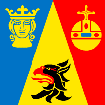
![[pile]](../images/v/vxt-d243c.gif)
National Flag of Eritrea (fotw); Flag of Houvet, Belgium (fotw); National Flag of Antigua-Barbuda (CS);
Flag of Stockholm County, Sweden (fotw); Example
Please note with regard to 1), however, that on
flags a triangular charge whose apex and/or base do not touch opposite edges
of the flag should be considered a triangle - see triangle.
- PILGRIMAGE PENNANT (or FLAG)
- A small triangular pennant, or occasionally a handwaver size flag, purchased as the souvenir
of a spiritual (usually Roman Catholic) pilgrimage, religious festival or special place of
worship, and often made from paper (see also handwaver).
- PILOT FLAG
- That flag which is flown by a vessel requiring or carrying a pilot, now
either G for Golf (if requiring a pilot) or H for Hotel (if under pilotage)
from the International Code of Signal Flags (see also
International Code of Signal Flags and
signal flag).

From left: Signal Flag Golf (CS); Signal Flag Hotel (CS)
Please note however, that many countries originally
had their own designs for pilot flags, of which the UK version - that is the national
flag with a white border - is typical of the type and a rare survival (see civil
jack under jack and
pilot jack). See supplemental note:

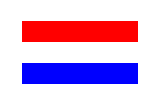
From left: Former Pilot Flag of Belgium (CS); Former Pilot Flag of The Netherlands (fotw)
- PILOT JACK
- In UK usage, originally a name for the national pilot flag, now an alternative
name for the civil jack (see civil jack under
jack, pilot flag and
union jack).
![[a pilot jack]](../images/v/vxt-d245.gif)
UK Pilot Jack (fotw)
- PINSEL (or PINCEL)
- A triangular pennant used by the authorized representative of a Scottish clan
chief in that persons absence. It has a solid field and is 0.60 x 1.35m long,
it is generally charged with the grantees crest within an annulet or ring (ensigned
with a coronet or bonnet dependent upon rank), and the grantees motto (see also
annulet,
ensigned,
guidon 3),
'pennon 3) and
ring).
- PIPE BANNER
- See bannerette.
- PIRATE FLAG
- See 'jolly roger'.
- PLACE OF HONOUR
- 1) On a flag see honour point 1).
- 2) Of a flag or coat of arms see position of honour.
- PLAIN
- 1) See undefaced.
- 2) On flags, the term that is applied to a flag which has monochrome field, or to
a bicolour, tricolour, triband or multi-stripe which carries no charges other than its
stripes, or to an undecorated border or panel consisting of a single colour (see also
bicolour 1) & 2),
border,
charge 1) & 2),
multi-stripe 1) - 4),
panel,
pierced 1),
triband 1) & 2) and
tricolour 1) & 2)).
- 3) In heraldry the term is sometimes used to describe a simple charge when it is
displayed in the same quarter of a coat of arms with another which is decorated or in
some way altered for example a plain chevron may be surrounded by an engrailed border
(see also bordure,
charge 1),
coat of arms 2),
chevron 1),
engrailed and
quarter 2)).
- PLANTAGENET CROWN
- See antique crown 1).
- PLATES
- A heraldic term for a number of particularly (but not exclusively) white or silver discs but see
quinas (also
bezant,
disc and
roundel 2)).

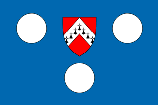

From left: example; Flag of Ichtegem, Belgium (fotw); Flag of Koelkelare, Belgium (fotw)
Please note that in strict English heraldic usage this term should only
be employed when the charge described is white/silver (argent) - see tinctures in
appendix III.
- POINT OF HONOUR
- See honour point.
- POINTED (or POINT-IN-POINT)
- A heraldic term for when the division of a shield forms a chevron usually with curved sides
- usually embowed -
at its base - point in point or enty (see also
base, chevron 1),
embowed and
shield 1))
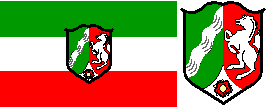
Flag and Arms of North Rhine Westphalia, Germany (CS)
- POLE
- See flag pole.
- POLE MAST
- A flagpole that is straight and clear of any projections such as cross bars,
yards, or gaffs (see also cross bar,
flag pole,
gaff and yard).
Please note that this term was originally introduced
to describe a mast or masts on those steam vessels not equipped with an auxiliary
sailing rig.
- POLITICAL FLAG
- 1) The flag, either official (formally adopted) or unofficial (spontaneously
displayed by supporters), of a political party or movement (see also
"tribal flag).
- 2) A flag, as opposed to a banner as defined herein, that is specifically
designed to express a political or popular sentiment - a protest flag (see also
banner 3) and note below).
![[political flags]](../images/v/vxt-d248.gif)
![[political flags]](../images/v/vxt-d248a.gif)
From left: African National Congress, RSA; American Indian Movement, USA; Communist Party, UK;
Polish Independence Movement Solidarity 1980s (fotw)
Please note with regard to 2) that, in both historical and/or contemporary terms,
a political flag and a trade union flag can often be very closely linked see
trade union flag.
- POMMED
- A term sometimes used to indicate the pommel of a sword or dagger but see
hilted
and following note (also hafted and
shafted).
- PORT EPEE
- See dress knot.
- PORTOLANO
- The term for a navigational chart of the 14th to the 16th Centuries, particularly showing
coastlines and ports and usually bearing illustrations of their arms and flags.
- POSITION OF HONOUR (OR HONOR)
- The position in which the most senior flag, emblem or coat of arms usually
a national flag, emblem or coat of arms - is to be placed - sometimes called
the place of honour. The particulars vary
slightly in detail, legal status and extent from country to country; however,
the general principles remain the same and are listed in
Appendix II (see also
rules of etiquette and
precedence).
Please note not to be confused with the honour point see
honour point.
- POSITIONAL FLAG
- 1) In US army usage, that flag which corresponds to a particular position
held, rather than to the rank of the officer who currently holds it but see
appointment flag (also
rank flag 1)).
- 2) See distinguishing flag 1).
![[positional flag example]](../images/v/vxt-d249.gif)
Army Surgeon General, US (fotw)
- POST FLAG
- See postal flag.
- POSTAL FLAG (ENSIGN or PENNANT)
- The distinguishing flag, ensign or pennant of a countrys postal services a mail flag/pennant or post
flag/pennant (see also air mail flag).

![[postal flag - Denmark]](../images/v/vxt-d251.gif)

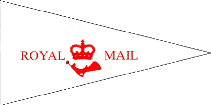
From left: Postal Flag, France (fotw); Postal Flag and Ensign of Denmark (fotw);
Postal Pennant, Poland (fotw); Royal Mail Pennant, UK (fotw)
- POSTURES
- A 16th/17th Century term for the formal flag waving expected of a colour bearer
for reasons of either bravado or dignity (see also
colour 2),
colour bearer,
company colours,
ensign 4),
flag tossing and
stand 1)).
- POW-MIA (PRISONER OF WAR-MISSING IN ACTION) FLAG
- See memorial flag 2).




![[pile]](../images/v/vxt-d243c.gif)






![[political flags]](../images/v/vxt-d248.gif)
![[political flags]](../images/v/vxt-d248a.gif)

![[postal flag - Denmark]](../images/v/vxt-d251.gif)





![[a pilot jack]](../images/v/vxt-d245.gif)

![[positional flag example]](../images/v/vxt-d249.gif)